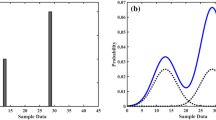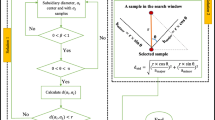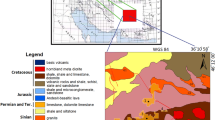Abstract
Identification of geochemical anomalies is of particular importance for tracing the footprints of anomalies. This can be implemented by advanced techniques of exploratory data analysis, such as fractal/multi-fractal approaches based on priori or posteriori distribution of geochemical elements. The latter workflow involves analysis of 2D/3D produced maps, which can be mostly obtained by geostatistical algorithms. There are two challenging issues for such an analysis. The first one corresponds to handling the cross-correlation structures among the data, and the second one relates to the compositional nature of data. To tackle these problems, this paper investigates the application of Gaussian co-simulation for modeling the cross-correlated compositional data in order to recognize the multivariate geochemical anomalies in integration with fractal analysis. In this context, an innovative algorithm, namely co-simulated size number (CoSS-N), is introduced for this purpose. The compositional nature of data is addressed by additive log-ratio transformation of original data while the Gaussian co-simulation handles the reproduction of cross-correlation among the components. The co-simulated outputs are then taken into account for capturing different geochemical populations, showing different levels of backgrounds and anomalies. The algorithm is illustrated via a real case study located in Philippine wherever seven geochemical components are required to be considered. The accuracy of results is examined by statistical validation techniques, indicating the capability of the CoSS-N algorithm for multivariate identification of geochemical anomalies.














Similar content being viewed by others
References
Abildin, Y., Madani, N., & Topal, E. (2019). A hybrid approach for joint simulation of geometallurgical variables with inequality constraint. Minerals,9(1), 24.
Adeli, A., Emery, X., & Dowd, P. (2018). Geological modelling and validation of geological interpretations via simulation and classification of quantitative covariates. Minerals,8(1), 7.
Afzal, P., Fadakar Alghalandis, Y., Khakzad, A., Moarefvand, P., & Rashidnejad Omran, N. (2011). Delineation of mineralization zones in porphyry Cu deposits by fractal concentration–volume modeling. Journal of Geochemical Exploration,108, 220–232.
Afzal, P., Khakzad, A., Moarefvand, P., Rashidnejad Omran, N., Esfandiari, B., & Fadakar Alghalandis, Y. (2010). Geochemical anomaly separation by multifractal modeling in Kahang (Gor Gor) porphyry system. Central Iran. Journal of Geochemical Exploration,104, 34–46.
Afzal, P., Madani, N., Shahbeik, Sh, & Yasrebi, A. B. (2015). Multi-Gaussian kriging: a practice to enhance delineation of mineralized zones by concentration–volume fractal model in Dardevey iron ore deposit, SE Iran. Journal of Geochemical Exploration,158, 10–21.
Agterberg, F. P. (1995). Multifractal modeling of the sizes and grades of giant and supergiant deposits. International Geology Review,37(1), 1–8.
Aitchison, J. (1982). The statistical analysis of compositional data. Journal of the Royal Statistical Society: Series B (Methodological),44(2), 139–177. (with discussion).
Aitchison, J. (1986). The statistical analysis of compositional data. Monographs on statistics and applied probability. London: Chapman & Hall Ltd. (Reprinted in 2003 with additional material by The Blackburn Press).
Aitchison, J., & Shen, S. M. (1980). Logistic-normal distributions. Some properties and uses. Biometrika,67(2), 261–272.
Almeida, A. S., & Journel, A. G. (1994). Joint simulation of multiple variables with a Markov-type coregionalization model. Mathematical Geology,26(5), 565–588.
Battalgazy, N., & Madani, N. (2019). Categorization of mineral resources based on different geostatistical simulation algorithms: A case study from an iron ore deposit. Natural Resources Research. https://doi.org/10.1007/s11053-019-09474-9.
Buccianti, A., & Pawlowsky-Glahn, V. (2005). New perspectives on water chemistry and compositional data analysis. Mathematical Geology,37(7), 703–727.
Carr, J. R., & Myers, D. E. (1985). COSIM: A FORTRAN IV program for coconditional simulation. Computers & Geosciences,11(6), 675–705.
Carranza, E. J. M. (2008). Geochemical anomaly and mineral prospectivity mapping in GIS. Handbook of exploration and environmental geochemistry (Vol. 11). Amsterdam: Elsevier.
Carranza, E. J. M. (2009). Controls on mineral deposit occurrence inferred from analysis of their spatial pattern and spatial association with geological features. Ore Geology Reviews,25, 383–400.
Carranza, E. J. M. (2010a). Catchment basin modelling of stream sediment anomalies revisited: incorporation of EDA and fractal analysis. Geochemistry: Exploration, Environment, Analysis,10, 365–381.
Carranza, E. J. M. (2010b). Mapping of anomalies in continuous and discrete fields of stream sediment geochemical landscapes. Geochemistry: Exploration, Environment, Analysis,10, 171–187.
Carranza, E. J. M. (2011). Analysis and mapping of geochemical anomalies using logratio-transformed stream sediment data with censored values. Journal of Geochemical Exploration,110, 167–185.
Chen, G., & Cheng, Q. (2018). Fractal-based wavelet filter for separating geophysical or geochemical anomalies from background. Mathematical Geosciences,50(3), 249–272.
Cheng, Q. (2012). Singularity theory and methods for mapping geochemical anomalies caused by buried sources and for predicting undiscovered mineral deposits in covered areas. Journal of Geochemical Exploration,122, 55–70.
Cheng, Q., Agterberg, F. P., & Ballantyne, S. B. (1994). The separation of geochemical anomalies from background by fractal methods. Journal of Geochemical Exploration,51, 109–130.
Cheng, Q., Agterberg, F. P., & Bonham-Carter, G. F. (1996). A spatial analysis method for geochemical anomaly separation. Journal of Geochemical Exploration,56(3), 183–195.
Cheng, Q., Xu, Y. & Grunsky, E. (1999). Integrated spatial and spectral analysis for geochemical anomaly separation. In: S. J. Lippard, A. Naess, & R. Sinding-Larsen (Eds.), Proceedings of the conference of the international association for mathematical geology (Vol. 1, pp. 87–92). Trondheim.
Cheng, Q., Xu, Y., & Grunsky, E. C. (2000). Integrated spatial and spectrum method for geochemical anomaly separation. Natural Resources Research,9, 43–52.
Chilès, J. P., & Delfiner, P. (2012). Geostatistics: Modeling spatial uncertainty (2nd ed.). New York: Wiley.
Deutsch, C. V., & Journel, A. G. (1998). GSLIB: Geostatistical software library and user’s guide. New York: Oxford University Press.
Egozcue, J., Pawlowsky-Glahn, V., Mateu-Figueras, G., & Barceló-Vidal, B. (2003). Isometric logratio transformations for compositional data analysis. Mathematical Geology,35(3), 279–300.
Emery, X. (2004). Testing the correctness of the sequential algorithm for simulating Gaussian random fields. Stochastic Environmental Research and Risk Assessment A,18(6), 401–413.
Emery, X. (2005). Variograms of order ω: A tool to validate a bivariate distribution model. Mathematical Geology,37(2), 163–181.
Emery, X. (2007). Conditioning simulations of Gaussian random fields by ordinary kriging. Mathematical Geology,39(6), 607–623.
Emery, X. (2008). A turning bands program for conditional co-simulation of cross-correlated Gaussian random fields. Computers & Geosciences,34(12), 1850–1862.
Emery, X. (2010). Iterative algorithms for fitting a linear model of coregionalization. Computers & Geoscience,36(9), 1150–1160.
Emery, X., & Lantuéjoul, C. (2006). TBSIM: A computer program for conditional simulation of three-dimensional Gaussian random fields via the turning bands method. Computer & Geoscience,32(10), 1615–1628.
Eze, P. N., Madani, N., & Adoko, A. C. (2019). Multivariate mapping of heavy metals spatial contamination in a Cu–Ni exploration field (Botswana) using turning bands co-simulation algorithm. Natural Resources Researches,28(1), 109–124.
Feder, J. (1988). Fractals (p. 283). New York: Plenum Press.
Filzmoser, P., Hron, K., & Reimann, C. (2009). Principal components analysis for compositional data with outliers. Environmetrics,20, 621–632.
Gneiting, T. (1999). The correlation bias for two-dimensional simulations by turning bands. Mathematical Geology,31(2), 195–211.
Gómez-Hernández, J. J., & Journel, A. G. (1993). Joint sequential simulation of multigaussian fields. In A. Soares (Ed.), Geostatistics Tróia’92 (Vol. 1, pp. 85–94). Dordrecht: Springer.
Goovaerts, P. (1997). Geostatistics for natural resources evaluation. New York: Oxford University Press.
Goovaerts, P. (1999). Impact of the simulation algorithm, magnitude of ergodic fluctuations and number of realizations on the spaces of uncertainty of flow properties. Stochastic Environmental Research and Risk Assessment,13(3), 161–182.
He, J., Yao, S., Zhang, Z., & You, G. (2013). Complexity and productivity differentiation models of metallogenic indicator elements in rocks and supergene media around Daijiazhuang Pb–Zn deposit in Dangchang County, Gansu Province. Natural Resources Research,22, 19–36.
Hogg, R. V., McKean, J., & Craig, A. T. (2012). Introduction to mathematical statistics (7th ed.). Harlow: Pearson Education Ltd.
Hosseini, S. A., & Asghari, O. (2019). Multivariate geostatistical simulation on block-support in the presence of complex multivariate relationships: Iron ore deposit case study. Natural Resources Research,28, 125–144.
JICA-MMAJ. (1986). Report on mineral exploration, mineral deposits and tectonics of two contrasting geologic environments in the Republic of the Philippines, Phase II (Masbate and Leyte Areas). Tokyo: Japan International Cooperating Agency and Metal Mining Agency of Japan.
Job, M. (2010). Application of logratios for compositional data. Centre for Computational Geostatistics Report 12, 307. University of Alberta, Canada.
Journel, A. B., & Huijbregts, C. J. (1978). Mining geostatistics. New York: Academic.
Lantuéjoul, C. (1994). Non conditional simulation of stationary isotropic multigaussian random functions. In M. Armstrong & P. A. Dowd (Eds.), Geostatistical simulations (pp. 147–177). Dordrecht: Kluwer.
Lantuéjoul, C. (2002). Geostatistical simulation: Models and algorithms. Berlin: Springer.
Leuangthong, O., McLennan, J. A., & Deutsch, C. V. (2004). Minimum acceptance criteria for geostatistical realizations. Natural Resources Research,13, 131–141.
Li, C., Xu, Y., & Jiang, X. (1994). The fractal model of mineral deposits. Geology of Zhejiang,10, 25–32. (in Chinese with English abstract).
Luz, F., Mateus, A., Matos, J. X., & Gonçalves, M. A. (2014). Cu- and Zn-soil anomalies in the NE border of the South Portuguese Zone (Iberian Variscides, Portugal) identified by multifractal and geostatistical analyses. Natural Resources Research,23, 195–215.
Madani, N., & Emery, X. (2019). A comparison of search strategies to design the cokriging neighborhood for predicting coregionalized variables. Stochastic Environmental Research and Risk Assessment,33(1), 183–199.
Madani, N., & Sadeghi, B. (2019). Capturing hidden geochemical anomalies in scarce data by fractal analysis and stochastic modeling. Natural Resources Research,28(3), 833–847.
Mandelbrot, B. B. (1983). The fractal geometry of nature. San Fransisco: W. H. Freeman.
Matheron, G. (1973). The intrinsic random functions and their applications. Advances in Applied Probability,5(3), 439–468. https://doi.org/10.2307/1425829.
Mery, N., Emery, X., Cáceres, A., Ribeiro, D., & Cunha, E. (2017). Geostatistical modeling of the geological uncertainty in an iron ore deposit. Ore Geology Reviews,88, 336–351.
Mitchell, A. H. G., & Leach, T. M. (1991). Epithermal gold in the Philippines: Island arc metallogenesis. Geothermal Systems and Geology. London: Academic Press.
Monecke, T., Monecke, J., Herzig, P. M., Gemmell, J. B., & Monch, W. (2005). Truncated fractal frequency distribution of element abundance data: A dynamic model for the metasomatic enrichment of base and precious metals. Earth Planetary Science Letters,232, 363–378.
Mueller, U., Tolosana-Delgado, R., & van den Boogaart, K. G. (2014). Simulation of compositional data: A nickel laterite case study. In R. Dimitrakopoulos (Ed.), Advances in orebody modelling and strategic mine planning. Melbourne: AusIMM.
Myers, D. E. (1989). Vector conditional simulation. In M. Armstrong (Ed.), Geostatistics (pp. 283–293). Dordrecht: Springer.
Olea, R. A., Luppens, J. A., Egozcue, J. J., & Pawlowsky-Glahn, V. (2016). Calorific value and compositional ultimate analysis with a case study of a Texas lignite. International Journal of Coal Geology,162, 27–33.
Paravarzar, S., Emery, X., & Madani, N. (2015). Comparing sequential Gaussian and turning bands algorithms for cosimulating grades in multi-element deposits. Comptes Rendus Geoscience,347(2), 84–93.
Pawlowsky-Glahn, V. (1984). On spurious spatial covariance between variables of constant sum. Science de la Terre Information Géologie,21, 107–113.
Pawlowsky, V., & Burger, H. (1992). Spatial structure analysis of regionalized compositions. Mathematical Geology,24, 675–691.
Pawlowsky-Glahn, V. (2003). Statistical modelling on coordinates. In S. Thió-Henestrosa & J. A. Martín-Fernández (Eds.), Proceedings of CoDaWork’03, the 1st compositional data analysis workshop. Girona (E): Universitat de Girona. ISBN 84–8458-111-X. Retrieved April 18, 2019 from http://ima.udg.es/Activitats/CoDaWork2003/.
Pawlowsky-Glahn, V., & Egozcue, J. J. (2016). Spatial analysis of compositional data: A historical review. Journal of Geochemical Exploration,164, 28–32.
Pawlowsky-Glahn, V., Egozcue, J. J., & Tolosana-Delgado, R. (2015). Modelling and analysis of compositional data. New York: Wiley.
Pawlowsky-Glahn, V., & Olea, R. A. (2004). Geostatistical analysis of compositional data. Studies in mathematical geology (Vol. 7). Oxford: Oxford University Press.
Pebesma, E. J. (2004). Multivariable geostatistics in S: The gstat package. Computers & Geosciences,30(7), 683–691.
Reimann, C., Filzmoser, P., Garrett, R. G., & Dutter, R. (2008). Statistical data analysis explained: Applied environmental statistics with R (No. Sirsi) i9780470985816. Chichester: Wiley.
Rivoirard, J. (1994). Introduction to disjunctive kriging and nonlinear geostatistics. Oxford: Oxford University Press.
Rossi, M. E., & Deutsch, C. V. (2014). Mineral resource estimation. Dordrecht: Springer.
Rubio, R. H., Costa, J. F. C. L., & Bassani, M. A. A. (2016). A geostatistical framework for estimating compositional data avoiding bias in back-transformation. Rem: Revista Escola de Minas,69(2), 219–226.
Sadeghi, B., Madani, N., & Carranza, E. J. M. (2015). Combination of geostatistical simulation and fractal modeling for mineral resource classification. Journal of Geochemical Exploration,149, 59–73.
Sadeghi, B., Moarefvand, P., Afzal, P., Yasrebi, A. B., & Saein, L. D. (2012). Application of fractal models to outline mineralized zones in the Zaghia iron ore deposit, Central Iran. Journal of Geochemical Exploration,122, 9–19.
Shi, J., & Wang, C. (1998). Fractal analysis of gold deposits in China: Implication for giant deposit exploration. Earth Sciences Journal of China University of Geosciences,23, 616–618. (in Chinese with English abstract).
Talebi, H., Mueller, U., & Tolosana-Delgado, R. (2019). Joint simulation of compositional and categorical data via direct sampling technique—Application to improve mineral resource confidence. Computer & Geosciences,122, 87–102.
Tolosana-Delgado, R. (2006). Geostatistics for constrained variables: Positive data, compositions and probabilities. Application to environmental hazard monitoring. Retrieved April 18, 2019 from http://www.tesisenxarxa.net/TDX-0123106-122444/index_an.html.
Tolosana-Delgado, R., Mueller, U., & van den Boogaart, K. G. (2018). Geostatistics for compositional data: An overview. Mathematical Geosciences. https://doi.org/10.1007/s11004-018-9769-3.
Tolosana-Delgado, R., Otero, N., & Pawlowsky-Glahn, V. (2005). Some basic concepts of compositional geometry. Mathematical Geology,37(7), 673–680.
Tolosana-Delgado, R., & van den Boogaart, K. G. (2013). Joint consistent mapping of high-dimensional geochemical surveys. Mathematical Geosciences,45, 983–1004.
Turcotte, D. L. (1996). Fractals and chaos in geophysics (2nd edn) (pp. 81–99). Cambridge: Cambridge University Press.
Van den Boogaart, K. G., Mueller, U., & Tolosana-Delgado, R. (2017). An affine equivariant multivariate normal score transform for compositional data. Mathematical Geosciences,49, 231–251.
Wackernagel, H. (2003). Multivariate geostatistics: An introduction with applications. Berlin: Springer.
Zuo, R., Cheng, Q., & Xia, Q. (2009). Application of fractal models to characterization of vertical distribution of geochemical element concentration. Journal of Geochemical Exploration,102, 37–43.
Zuo, R., & Wang, J. (2016). Fractal/multifractal modeling of geochemical data: A review. Journal of Geochemical Exploration,164, 33–41.
Acknowledgments
The first author acknowledges the Nazarbayev University for supporting this work through Faculty Development Competitive Research Grants for 2018–2020 under Contract No. 090118FD5336.
Author information
Authors and Affiliations
Corresponding author
Rights and permissions
About this article
Cite this article
Madani, N., Carranza, E.J.M. Co-simulated Size Number: An Elegant Novel Algorithm for Identification of Multivariate Geochemical Anomalies. Nat Resour Res 29, 13–40 (2020). https://doi.org/10.1007/s11053-019-09547-9
Received:
Accepted:
Published:
Issue Date:
DOI: https://doi.org/10.1007/s11053-019-09547-9




